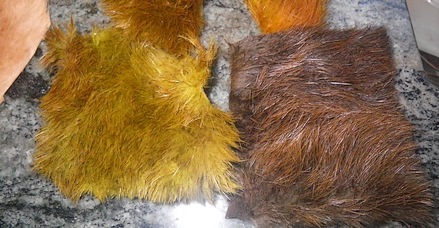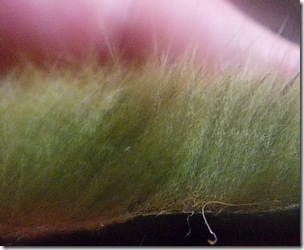You hear the term often in fly tying, you just don’t see anyone actually doing the deed – outside of the occasional Peacock eye made hairless by swishing it around in caustic bleach, which is about all I’ve ever seen anyone do …
Which makes a lot of sense, as everytime I’ve touched the bottle it meant I had more than enough and didn’t mind destroying a couple square feet.
I’ve always accused dyeing as the Destroyer of Materials, but that’s just to scare them with weak constitutions. When the material dries you may not have a good color, but at least you’ve got something …
… watching something bleach will cure you of the temptation to do it again. Soaking a piece of fur in straight bleach is not what you’d expect; the bath starts to heat to the point where it may melt the plastic bowl, likely a reaction to chemicals the hide was steeped in during the tanning or hide preparation process, then hair and flesh start vanishing and the rest turns into a flesh colored slag that covers what’s left of the fur with a gooey bubblegum residue.
Eventually you kind of back away until the temperature lowers to the point you can toe what’s left into the trash.
Bleached hair patches and lightened colors on furs and feathers have typically been treated with Hydrogen Peroxide or similar lightening agent.
Hydrogen Peroxide is available in any supermarket or local drugstore, it’s an antiseptic and is sold as a 3% solution in the aisle with medical supplies and liniments. This concentration can lighten hair (human and animal) with numerous applications or one long soak.

The center color above was “bleached” in a single bath of 3% peroxide. It took 92 hours to achieve this color from its natural gray. Four additional pieces I’ve dyed yellow ring the bleached color. As it is now, tossing a chunk into a drawer ensures a lifetime of Light Cahill’s.

Natural beaver is much too dark to be able to dye into light colors, at best it’ll turn muddy-dark. The above pieces were dyed in the identical pot for the same amount of time. Only the bleached hide can achieve the light olive I was attempting.

So long as the fur is completely submerged the peroxide bath will ensure consistency of color. Note in the above photo how the Olive color is uniform from downy underfur to the tips. This is done by first pumping the back of the hide to force all the air bubbles out of the material, then dumping the result straight into the solution without wringing.
Beaver guard hairs will resist the dye mightily, and might only take on a tint of the desired color, this is true of most tough hair, especially those of the aquatic mammals.

Hair stylists use a powdered lightener along with Hydrogen Peroxide to avoid “orangey” colored hair like the above. Internet forums mention that straight peroxide often yields an orange effect on human hair. Once the fibers are any shade close they should be pulled and dried anyways, as they’ll lighten into a tan-orange which is perfect for our later applications of dye.
Peroxide is available in food grade as well; solutions ranging between 8% and 35% and a cost commensurate. These will cut the time down significantly, 12% took the same beaver from gray to tan in just over 18 hours, but the solution costs around a dollar an ounce at that concentration. Most of the higher concentrations have to be mail ordered and signed for by someone over 18 as well.
Every animal is a bit different both in qualities and texture of their hair, and degree of lightening needed to reduce their natural color to something light enough for dye. It’s best to experiment with small chunks to determine how long the base 3% will take to render an appropriate shade for your use.
Just tuck a large bowl of the cheap stuff ($2.00) into the garage, carve the hides into 5×5 pieces and check the mix come the weekend, there’s little risk of it getting too light.

Lots of great information, thanks.